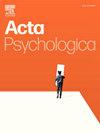From menus to misbeliefs: Absolute frequencies of healthy and tasty dishes predict the unhealthy = tasty belief in restaurants
IF 2.1
4区 心理学
Q2 PSYCHOLOGY, EXPERIMENTAL
引用次数: 0
Abstract
We examine whether the prevalence of healthy and tasty food options in restaurant menus leads to the formation of beliefs about the relationship between healthiness and taste that deviate from the correlation of healthiness and taste ratings. Participants (N = 195) rated the healthiness and taste of twelve dishes from two different restaurant types (American and vegetarian restaurants), estimated the frequencies of healthy and tasty options, and reported their health-taste beliefs. Results show that ratings of perceived healthiness and expected taste are uncorrelated in both restaurant types, but participants formed the misbelief that unhealthy dishes taste better than healthy dishes to a greater extent in American than in vegetarian restaurants. Regression analyses revealed that the absolute frequencies of food options were significantly related to participants' health-taste beliefs while controlling for the correlation between healthiness and taste ratings in both restaurant types. Participants were more likely to believe that healthy food tastes better than unhealthy food when they perceived that healthy and tasty food were both frequent (or infrequent) in the respective restaurant type. Our results provide evidence that relying on absolute frequencies, rather than covariation, to infer the relationship between healthiness and taste may lead to misbeliefs that do not reflect the health-taste correlation of individual food items.
从菜单到误解:健康和美味菜肴的绝对频率可预测餐厅中不健康=美味的信念。
我们研究了餐厅菜单中健康和美味食物选项的普遍性是否会导致人们对健康和美味之间的关系形成偏离健康和美味评分相关性的信念。参与者(N = 195)对两种不同类型餐厅(美式餐厅和素食餐厅)的 12 种菜肴的健康度和口味进行了评分,估计了健康和美味选项的频率,并报告了他们的健康-口味信念。结果表明,在这两种类型的餐厅中,对健康感知和预期口味的评分是不相关的,但参与者形成的不健康菜肴比健康菜肴更美味的错误信念在美式餐厅中比在素食餐厅中更严重。回归分析表明,在控制两类餐厅的健康度和口味评分之间的相关性的情况下,食物选项的绝对频率与参与者的健康口味信念有显著关系。当参与者认为在相应类型的餐厅中,健康和美味的食物都经常出现(或不经常出现)时,他们更有可能认为健康食物比不健康食物更美味。我们的研究结果证明,依靠绝对频率而非协变关系来推断健康与美味之间的关系,可能会导致错误的信念,而这种信念并不能反映单个食品的健康与美味之间的相关性。
本文章由计算机程序翻译,如有差异,请以英文原文为准。
求助全文
约1分钟内获得全文
求助全文
来源期刊

Acta Psychologica
PSYCHOLOGY, EXPERIMENTAL-
CiteScore
3.00
自引率
5.60%
发文量
274
审稿时长
36 weeks
期刊介绍:
Acta Psychologica publishes original articles and extended reviews on selected books in any area of experimental psychology. The focus of the Journal is on empirical studies and evaluative review articles that increase the theoretical understanding of human capabilities.
 求助内容:
求助内容: 应助结果提醒方式:
应助结果提醒方式:


